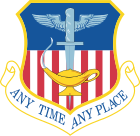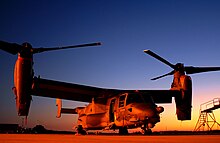1st Special Operations Wing
|
1st Special Operations Wing |
|
|---|---|
|
Emblem of the 1st SOW |
|
| Lineup | March 1944 |
| Country | United States of America |
| Armed forces | United States Armed Forces of America |
| Air Force | United States Air Force |
| Subordinate troops |
( see below ) |
| Hurlburt Field ( Eglin Air Force Base ) u. a. | Florida |
| motto | "Any Time, Any Place" |
| Awards | Presidential Unit Citation , Air Force Outstanding Unit Award |
| commander | |
| Current commander |
Col. James Slife |
| Aircraft | |
|
Transport aircraft / helicopter |
Lockheed C-130 , v. a. the models MC-130E Combat Talon I, MC-130H Combat Talon II, MC-130P Combat Shadow and MC-130W Combat Spear; CV-22 Osprey |
The 1st Special Operations Wing (1st SOW) is next to the 27th SOW one of the two active Special Operations Wings of the US Air Force (USAF). The association is subordinate to the Air Force Special Operations Command (AFSOC) and has its home base in Hurlburt Field , part of Eglin Air Force Base , in the US state of Florida , where the headquarters of the AFSOC is also located. Some 1st SOW units are also stationed at Eglin Air Force Base, Florida and Nellis Air Force Base , Nevada .
history
The eponymous forerunner of the 1st SOW was the 1st Air Commando Group. It was named “Provisional Composite No. 1 Air Commandos ”to support General Wingate's British-Indian Chindits in the China-Burma-India theater of war. In March 1944, the unit received its final designation 1st Air Commando Group. The group united all airborne forces from fighters to transport aircraft at group level. It was disbanded on October 8, 1948 and set up again on April 18, 1962.
In the early 1960s, the US armed forces set up special guerrilla fighting units for the first time . The first unit of this type in the USAF was the early 1961 established 4400th Combat Crew Training Squadron (CCTS), which was code-named "Jungle Jim". It was later renamed 1st Air Commando Group, after the unit described above that was deployed in the South and East Asian theater of war during World War II.
The group specialized in tactics to support friendly ground forces in local conflicts. It did so under the code name Farm Gate from October 1961 in Laos and South Vietnam, where local crews were trained on the T-28 Trojan , C-47 Dakota and B-26 Invader . An external characteristic of the members of the unit was the wearing of the Australian bush hat.
On June 1, 1963, the unit was renamed 1st Air Commando Wing and on July 8, 1968, 1st Special Operations Wing.
On October 1, 1993, another renaming took place, triggered by the directive of the Air Force Chief of Staff General Merrill McPeak , which provided that two active units may not bear the same number. The USAF decided to rename it to the 16th Special Operations Wing, as the “competing” 1st Fighter Wing was given a higher weighting in the continuation of its name tradition.
In 2006, the establishment of a second Special Operations Wing was announced that on the Cannon Air Force Base ( New Mexico should be located). The USAF leadership decided that the unit stationed in Hurlburt should get its original name back and the new unit to be set up should be called the 16th SOW. The 1st SOW (and earlier 16th SOW) was given its old name on November 16, 2006.
With effect from October 1, 2007, the second SOW is currently called the 27th SOW and thus adopted the name tradition of the 27th Fighter Wing, which was previously located in Cannon AFB.
assignment
The main focus of the 1st SOW lies in the area of unconventional warfare. These include: counter-terrorism, search and recovery of forces in combat operations behind enemy lines, lockdown and close air support, psychological warfare and support of developing countries in building air forces. In addition, there is the provision of in-flight refueling capacities for other units that operate under special operating conditions.
Particularly noteworthy are the secret reconnaissance capabilities including situation and target analyzes for jointly operating special forces and for search and rescue operations.
organization
The unit comprises four main subdivisions:
- 1st Special Operations Group
- 1st Special Operations Maintenance Group
- 1st Special Operations Mission Support Group
- 1st Special Operations Medical Group
The largest unit here is the 1st Special Operations Group, which at the beginning of 2013 comprised six squadrons with fixed-wing and convertible aircraft . The Special Operations Maintenance Group maintains over half of this material and is also responsible for overseeing maintenance execution by contractors. The most diversified unit is the Special Operations Mission Support Group, which provides the personnel for construction-related tasks, logistics, communication and security tasks. The Special Operations Medical Group is naturally responsible for all health-related tasks of the unit, including the family members of the unit members.
The structure of the 1st Special Operations Group as of January 2013 is shown below. All units are stationed at Hurlburt Field in Florida, the only exception being the 9th SOS at Eglin AFB (Florida):
| Squadrons of the 1st Special Operations Group |
|---|
| 4th Special Operations Squadron AC-130U |
| 8th Special Operations Squadron CV-22B Osprey |
| 9th Special Operations Squadron - Eglin AFB, Fla. MC-130P |
| 15th Special Operations Squadron MC-130H |
| 34th Special Operations Squadron Pilate U-28A |
| 319th Special Operations Squadron U-28A |
equipment
The unit owns a variety of different aircraft types, from the Lockheed Martin AC-130 H Gunship to the General Atomics MQ-9 , an unmanned aerial vehicle (UAV).
Hercules
The Lockheed Martin C-130 Hercules, of which five different variants are in use, is represented most in number in the 1st SOW. The gunship versions AC-130H Specter and AC-130U Spooky are most in demand here . They are equipped with FLIR systems and low light level television ( LLLTV ) for their night missions . The AC-130H has two 20 mm M61A1 Vulcan automatic cannons , a 40 mm L / 60 Bofors cannon and a 105 mm howitzer on the left side of the aircraft. The AC-130U, on the other hand, uses a 25 mm GAU-12 Gatling machine gun instead of the two M61 on-board cannons . The 25 mm and 40 mm armament will be replaced by the Bushmaster 30 mm cannon by 2011 . The Spooky is able to attack two targets simultaneously and has twice the amount of ammunition than the H version. The AC-130U will also receive a number of avionics and fire control system improvements over the next few years to make it optimally suited for all-weather operations.
Since the need for gunships is viewed by the AFSOC as very high, considerations are going to use the Alenia C-27 J for this role as well. The trials began in July 2008 at Eglin AFB in Florida with a decommissioned C-27A.
The majority of the Hercules used belong to the M series variants. These are the MC-130E Combat Talon I, MC-130H Combat Talon II, MC-130P Combat Shadow and the MC-130W Combat Spear, which are used for all kinds of support tasks. This includes that all MC-130s are equipped for the in-flight refueling of the other AFSOC aircraft, as well as being able to carry out infiltration and evacuation missions and supply during operations.
AFSOC has started to replace the MC-130 fleet with 14 HC / MC-130J, a total of 68 new machines are to be purchased.
| variant | designation | number | crew | assignment |
|---|---|---|---|---|
| AC-130H | Specter | 8th | 13 | Close air support |
| AC-130U | Spooky | 17th | 13 | Close air support |
| MC-130E | Combat Talon I | 14th | 9 | Infiltration, extraction, supply |
| MC-130H | Combat Talon II | 24 | 7th | Infiltration, extraction, supply |
| MC-130P | Combat Shadow | 28 | 7th | In-flight refueling |
| MC-130W | Combat Spear | 12 | 7th | Infiltration, extraction, supply |
Rotary wing aircraft
The Sikorsky MH-53 Pave Low (A) has been an important part of the AFSOC equipment since 1980. Originally, four squadrons were equipped with the 39 aircraft that were acquired. The last version in use was the MH-53M Pave Low IV. The last copy was retired on September 30, 2008 and the 20th SOS was subsequently deactivated.
The MH-53 is being replaced by the tilt-wing aircraft CV-22 Osprey , the first copies received the 1st SOW in 2006. They are currently used in the 8th SOS, although the initial operational capability is expected for 2009. The 1st SOW wants to procure a total of 50 CV-22s. The greatest advantage over the MH-53 is the significantly greater range of the CV-22B.
Other aircraft
In recent years, unmanned aerial vehicles have also been put into service with the 1st SOW. The General Atomics MQ-1 Predator and General Atomics MQ-9 Reaper are used for reconnaissance and ground attack tasks on the 3rd SOS.
Also new is the Pilatus PC-12 (U-28A), which is assigned to the 319th SOS and is used for intra-theater transport of emergency services and material.
(A) Pave stands for: Precision Avionics Vectoring Equipment , Low indicates the low altitude at which the MH-53 operated.
literature
- Rick Llinares: Air Commandos - 1st Special Operations Wing. In: Air International. Vol. 75, No. 5, November 2008, ISSN 0306-5634 , pp. 26-31.
Web links
Individual evidence
- ↑ Tom Kaminski: USAF Air Power 2013 , in Combat Aircraft Monthly, February 2013, p. 51



